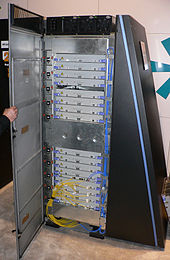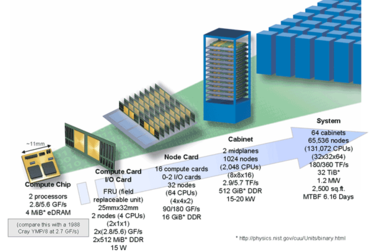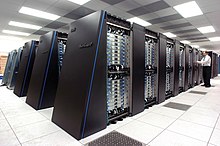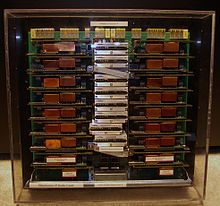Blue genes
Blue Gene is a project to design and build high-end computer technology. According to IBM, this should serve both to explore the limits of supercomputing in computer architecture , to develop the software necessary for programming and control of massively parallel systems and to use computing power for a better understanding of biological processes such as protein folding . The latter was also responsible for the naming.
In December 1999, IBM announced a five-year program to build a massively parallel computer to help research into biomolecular phenomena such as protein folding. The objective was to achieve speeds in the Peta - FLOPS range.
It is a cooperative project between the US Department of Energy (which also partially finances the project), industry (especially IBM), and universities. Five Blue Gene projects are under development, including Blue Gene / L, Blue Gene / P and Blue Gene / Q (see Advanced Simulation and Computing Program ).
Blue Gene / L was planned as the first architecture. The specifications were for a system with a peak performance of 360 TFLOPS on 65,536 nodes and completion in 2004/2005. The subsequent machines should achieve up to 1000 TFLOPS (Blue Gene / P, 2006/2007) or 3000 TFLOPS (Blue Gene / Q, 2007/2008). The continuous output of these successor systems from Blue Gene / L should be 300 TFLOPS or 1000 TFLOPS.
The chief architects of the project at IBM included Monty Denneau and Alan Gara .
Blue Gene / L
Blue Gene / L is a family of supercomputers that are very scalable . The project is jointly funded by IBM and the Lawrence Livermore National Laboratory .
The architecture consists of a basic building block (node or compute chip) that can be repeated over and over without creating bottlenecks . Each node of the BG / L consists of an ASIC with an associated DDR - SDRAM memory. Each ASIC in turn contains two 0.7 GHz PowerPC Embedded 440 processor cores , two "Double Hummer" FPUs, a cache subsystem and a communication subsystem .
The double TFlops rates (2.8 or 5.6 TFLOPS) on various drawings in the network result from the fact that an ASIC with two processors can be operated in two modes, which either use both processors for computing tasks, or only one for arithmetic tasks and the other as a coprocessor for communication tasks. A high-speed network with a 3D torus topology and a hierarchical network for collective operations are available for communication between the processors .
The Torus network is accessed via memory-mapped network adapters in order to achieve very low latency times, similar to InfiniBand . A modified MPI CH2 implementation was developed for communication . A specially programmed, very small POSIX kernel that does not support multitasking runs on the computing node - the running program is the only process on the system.
In the November 2004 edition of the TOP500 list, the Blue Gene / L system, which is still under construction at the Lawrence Livermore National Laboratory with 16 racks (16,384 nodes, corresponds to 32,768 processors), took the top spot. Since then it has been expanded step by step and on October 27, 2005 it reached 65,536 knots over 280 TFLOPS, which earned him the lead in the TOP500 11/2005. Although this expansion stage was originally declared as the final expansion, it was expanded again in 2007 and has since provided over 478 TFLOPS with 212,992 processors in 104 racks. This made it the fourth fastest system in the world in mid-2008.
The architecture is also suitable for other installations such as the Blue Gene Watson (BGW) at IBM's own Thomas J. Watson Research Center (98th place in TOP500 6/2011), JUGENE (Jülich Blue Gene at Forschungszentrum Jülich , June 2011 with place 12 even before its predecessor) and six other entries in the Top 100. These all fall under the name eServer Blue Gene Solution .
Blue Gene / P
The Blue Gene / P series was first presented in June 2007 at the ISC in Dresden. The changes compared to BG / L include the use of PowerPC 450 cores clocked at 850 MHz, four of which are now contained in one node. Each compute card now only has one instead of two such nodes, but a node card as the next larger unit contains 32 instead of 16 such compute cards.
Otherwise the components have remained the same and a rack thus contains twice as many processors as a BG / L. With an increase in performance of each processor of around 21% (at least with the LINPACK ) parallel to the increase in clock rate , each rack now provides 14 instead of 5.6 TFLOPS (each R peak ). The memory bandwidth grew at the same rate, the bandwidth of the Torus network was more than doubled from 2.1 GB / s to 5.1 GB / s and the latency times halved. According to the manufacturer, the energy requirement has only increased by 35%. For a system consisting of 72 racks that is supposed to reach the Peta-FLOPS limit, that's around 2.3 megawatts .
One of the first deliveries was made to Forschungszentrum Jülich , where it is operated under the name JUGENE and, with 180 TFLOPS, was 11th in the TOP500 list at the end of 2008. In November 2008, seven Blue Gene / P systems were among the 100 fastest systems worldwide.
On May 26, 2009, an improved version of JUGENE ( Jülich Blue Gene ) was inaugurated, in which the number of processors was increased from 65,536 to 294,912, thus achieving a peak performance of 1 petaflops . This computer was thus one of the fastest computers in Europe in 2012 and was ranked 13th among the fastest supercomputers in the world in the TOP500 list from November 2011.
Blue Gene / Q
The latest supercomputer design in the range, Blue Gene / Q, aimed to hit 20 petaflops in the time frame by 2011. It is designed as a further improvement and extension of the Blue Gene / L and P architectures with a higher clock frequency and significantly improved energy efficiency. Blue Gene / Q has a comparable number of nodes, but 16 instead of 4 cores per node (newly developed POWER CPU A2).
The reference installation of a Blue Gene / Q system called IBM Sequoia took place at the Lawrence Livermore National Laboratory in 2011 as part of the "Advanced Simulation and Computing Program"; it is used for nuclear simulations and other advanced scientific research.
A Blue Gene / Q system called Mira was installed at Argonne National Laboratory in early 2012. It consists of approx. 50,000 computing nodes (16 computing cores per node), 70 PByte disk storage (with 470 GByte / s I / O bandwidth) and is cooled with water.
Also in 2012, FERMI went into operation in the CINECA data center near Bologna, an installation with 10,240 Power A2 sockets with 16 cores each.
Further development
Newer IBM supercomputers no longer bear the name Blue Gene. They are based on a much more advanced POWER processor platform and the latest version (2018) is in trial operation at the Lawrence Livermore National Laboratory and the Oak Ridge National Laboratory, for example .
In addition to classic supercomputers, IBM has started developing and building neural supercomputers with extremely low power consumption.
Web links
- IBM Research: Blue Gene (English)
- IBM REDP-4247-00: Evolution of the IBM System Blue Gene Solution (English, An IBM Redpaper publication )
- Installation at the LLNL with lots of information (English)
credentials
- ↑ F. Allen, G. Almasi, W. Andreoni, D. Beece, BJ Berne, A. Bright, J. Brunheroto, C. Cascaval, J. Castanos, P. Coteus, et al .: Blue Gene: A vision for protein science using a petaflop supercomputer . In: IBM Systems Journal . tape 40 , no. 2 , 2001, p. 310–327 , doi : 10.1147 / sj.402.0310 ( archive.org ).
- ↑ CD Wait: IBM PowerPC 440 FPU with complex arithmetic extensions . In: IBM Journal of Research and Development . tape 49 , no. 2.3 , 2005, p. 249-254 , doi : 10.1147 / rd.492.0249 ( archive.org ).
- ↑ From 100 teraflops to 1 petaflops: Three new supercomputers in Jülich , press release on heise-online from May 26, 2009
- ↑ TOP500 list from November 2011 , TOP500 list. Retrieved January 30, 2012
- ↑ 17th Machine Evaluation Workshop ( Memento from October 31, 2008 in the Internet Archive )
- ↑ Processor whisper of 16 and 17 core cores
- ^ Minutes Advanced Scientific Computing Advisory Committee Meeting Nov. 3-4, 2009, Oak Ridge Associated Universities, Oak Ridge, Tenn. ( Memento from March 29, 2010 in the Internet Archive )
- ↑ The View from Germatown - ALCF Getting Started Workshop January 27-29, 2010 ( Memento of May 27, 2010 in the Internet Archive )
- ↑ FERMI reconfirmed in the Top500 top-ten
- ↑ Sven Oehme: CORAL Performance Update. November 11, 2017. Retrieved May 19, 2018 .
- ↑ Brain-inspired supercomputer for LLNL. March 29, 2016. Retrieved May 19, 2018 .
- ^ Brian Wang: Neural supercomputer for US Air Force Research Laboratory. June 24, 2017. Retrieved May 19, 2018 .
- ^ AFRL Anticipates Arrival of Neuromorphic Supercomputer . In: SIGNAL Magazine . January 25, 2018 ( afcea.org [accessed May 19, 2018]).



